Indirana tenuilingua is a species of frog that is considered nomen inquirendum. It is only known from the type series, now lost, from its type locality, Kemphole, in the Western Ghats of India. It is sometimes known as Rao's Indian frog or slender-tongued frog.
Bokermannohyla clepsydra is a species of frogs in the family Hylidae.
Boana beckeri is a species of frog in the family Hylidae. It is endemic to Brazil and is only known from a handful of localities in southern Minas Gerais and adjacent northeastern São Paulo. The specific name beckeri honors Johann Becker, Brazilian zoologist who collected many of the types.

Troschel's treefrog, also known as the blue-flanked treefrog or the convict treefrog, is a species of frog in the family Hylidae. It is found in most parts of the Amazon Basin, except in the southeast and the Guianas. Colombian, Venezuelan, and Surinamese records need confirmation.
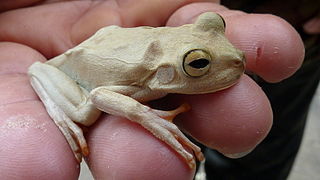
The emerald-eyed tree frog is a species of frog in the family Hylidae. It is largely restricted to the Atlantic Forest region of Brazil. Some populations previously regarded as Boana crepitans have been separated into the species Boana xerophylla and Boana platanera.

The Amapa tree frog is a species of frog in the family Hylidae found in northern Brazil in the Amapá state, French Guiana, and southeastern Suriname. It belongs to the Boana albopunctata species group.
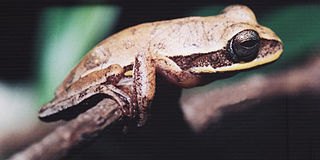
Boana ericae is a species of frog in the family Hylidae. It is endemic to Brazil and only known from its type locality, Chapada dos Veadeiros National Park in the Goiás state. The specific name ericae honors Erica Maria Pellegrini Caramaschi, a Brazilian ichthyologist.

Boana exastis is a species of frog in the family Hylidae. It is endemic to the Northeast Region of Brazil and has been recorded from Bahia, Alagoas, and Pernambuco.

Gunther's banded tree frog is a species of frog in the family Hylidae. The species was re-delimited in 2014 and the most of the earlier records assigned to this species refer to Boana maculateralis, Boana alfaroi, Boana tetete, and possibly also to an unnamed species. It is known with certainty only from the upper and lower montane forests on the western edge of the Amazon Basin in Ecuador and Peru, at elevations of 730–1,530 m (2,400–5,020 ft) above sea level.
Hypsiboas hypselops is a nomen dubium. It was originally given by Edward Drinker Cope in 1871 to specimen(s) collected from Pebas in northeastern Peru. However, Cope did not designate types, and whereabouts of the specimen(s) he used are unknown. Based on George Albert Boulenger's statement that it can be distinguished from Hyla crepitans by its acuminate snout, larger eye, and anterior femoral bands, the name Hypsiboas hypselops likely refers to some Boana species, but it is not possible to associate it with any particular known species.
Boana joaquini is a species of frog in the family Hylidae that is endemic to Brazil. Its natural habitats are subtropical or tropical seasonally wet or flooded lowland grassland, subtropical or tropical high-altitude grassland, rivers, and pastureland.
Boana latistriata is a species of frog in the family Hylidae. It is endemic to Brazil and only known from its type locality, Itatiaia National Park, and from Marmelópolis, both in the state of Minas Gerais. The specific name latistriata refers to the wide stripes on the back of this frog.
Boana phaeopleura is a species of frog in the family Hylidae that is endemic to Brazil. Its natural habitats are subtropical or tropical dry forests, moist savanna, subtropical or tropical moist shrubland, subtropical or tropical high-altitude shrubland, and rivers. It is threatened by habitat loss.
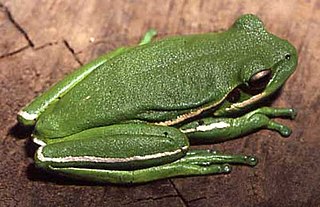
Boana prasina is a species of frog in the family Hylidae. It is endemic to Southeastern Brazil and known from the states of Minas Gerais, Rio de Janeiro, and São Paulo, and possibly further south. Common name Burmeister's treefrog has been proposed to this species.
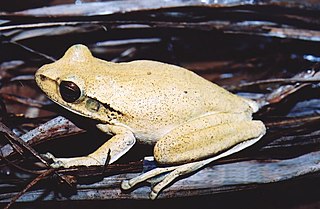
The Chaco tree frog is a frog species in the family Hylidae found in Argentina, Bolivia, Brazil, Colombia, French Guiana, Paraguay, and Venezuela.
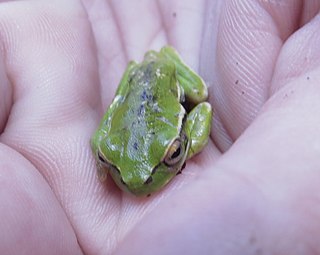
Boana riojana is a species of frog in the family Hylidae. It is found in the Eastern Andes and Andean foothills between La Rioja Province in Argentina and northern Bolivia, and possibly further into adjacent Peru. Common name Carrizo's tree frog has been used when referring to the formerly recognized Boana varelae(Carrizo, 1992).
Hoogmoed's tree frog is a species of frog in the family Hylidae found in Guyana, possibly Brazil, and possibly Venezuela. Its natural habitats are subtropical or tropical moist montane forests and rivers.
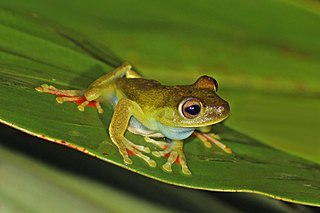
The Canal Zone tree frog is a species of frog in the family Hylidae found in the Caribbean lowlands of eastern Nicaragua, Costa Rica, and central Panama, as well as the Pacific lowlands of Colombia, although the latter records are uncertain and may refer to Boana rosenbergi.
The Barro Branco tree frog is a species of frog in the family Hylidae endemic to Brazil. Its natural habitats are subtropical or tropical moist lowland forests, rivers, freshwater marshes, and intermittent freshwater marshes.

Boana pugnax, the Chirique-Flusse tree frog, is a frog in the family Hylidae. It is endemic to Panama, Colombia, and Venezuela. Scientists have seen it as high as 500 meters above sea level.











